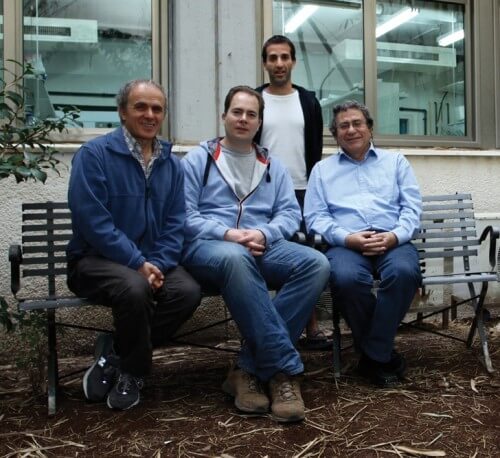The new findings of two groups of researchers at the Weizmann Institute challenge the previous assumptions about the steps in the protein production process

What one person threw away, so they say, may be valuable to another. Amit Zeizel, a research student from the group of Prof. Eitan Domani in the Department of Physics of Complex Systems, and Dr. Wolfgang Koestler, a physician and research student in the group of Prof. Yosef Yordan from the Department of Biological Control, did not discard information that seemed, on the face of it, to be meaningless. This information contributed new insights into the production of RNA in the cell.
The source of the new findings is in a previous study, in which the two studied the levels of messenger RNA - the molecules that carry the instructions for the production of proteins from a place that resides in the genes, outside the cell nucleus. The process of producing RNA involves, apparently, a certain amount of waste: it starts with pre-RNA molecules, which are a complete transcript of the genetic code found in DNA. From these molecules, certain segments - called exons - are derived and glued together in sequence, while other segments - called introns - remain outside the final RNA molecule. For the purpose of their research, Zeisel and Dr. Koestler used a research tool that allows them to follow the expression levels of these segments - exons and introns - as a function of time, when the cells respond to external stimulation.
The monitoring of changes in the expression levels of messenger RNA molecules of a particular gene, caused by external stimulation, is part of an ongoing study carried out jointly by Prof. Domani's and Prof. Jordan's groups, which deals with the timing of RNA production. Following the receipt of a certain signal, a series of genes in the cell are activated, and the RNA levels of the various genes begin to rise in steps that seem to be well timed: some reach their peak half an hour after the signal, while others reach their peak only an hour or two later. Most researchers simply ignore the information about the introns, as only the exons make it into the final instruction list. Zeisel and Dr. Koestler, who dealt with exons, were open to the possibility that the information concerning introns would also be found useful, and they left some of it in their data files. Thanks to this, they were able to notice a surprising finding: the production profile of the pre-RNA, as expressed in the amounts and timing of the production peak, was completely different from that of the messenger RNA.
The scientists realized that their accidental discovery enables a new method for measuring the pre-RNA activity of all expressed genes, at the same time. Their findings implied that the pre-RNA was created on a different schedule than the messenger RNA, and not, as was believed until then, in a parallel manner. To test the issue, they designed and performed a similar experiment, which included a more detailed and accurate measurement of both exons and introns. Also in this experiment, in some cases the pre-RNA levels rose quickly and sharply, reaching a peak earlier than that of the messenger RNA - which appeared at a later stage.
Later, the scientists collaborated with other groups at the institute, to test the validity of their findings in other types of cells, and under different conditions. They discovered that both in the cells of the immune system - which were tested in Prof. Stefan Jung's laboratory, and in the embryonic stem cells - which Dr. Yoav Suan researches, there are certain genes whose RNA production profile matches the pattern discovered in the original experiment.
The scientists called the high, narrow, early peaks in pre-RNA production "planned overproduction." Prof. Domani: "We start the observations at the moment when the cells receive the signal that activates a certain series of events. If the cells suddenly need a large amount of a certain protein, then a quick jump in pre-RNA may speed things up." He compares the principle to the integration of a vehicle into traffic on a highway: instead of gradually pressing the gas pedal until the new speed is reached, the driver will give "full gas" for a short time, in order to quickly reach the desired speed, and only then will he reduce the pressure he exerts on the pedal.
Each row represents one of the 400 genes that the growth factor EGF activates. Red colors indicate high expression levels. The expression profile shows that there is not always a match between the expression of the pre-RNA and the expression of the final RNA molecule. The gardens marked in green are those where there is "planned excess production"
The new findings challenge the previous assumptions regarding the steps in the protein production process, and besides, according to Prof. Dumani, it provides researchers with a set of known data, which allows them to calculate desired "unknown" data. Thus, for example, if the production profiles over time of the pre-RNA and the messenger RNA are known, it is possible to calculate both the production rate of the pre-RNA and the degradation rate of the RNA. E-messenger In fact, these findings help scientists create a more complete picture of messenger RNA control: excess production of pre-RNA and decay of messenger RNA act together as gas pedals and brakes to regulate gene levels manifested over time. Now the team is monitoring the protein levels, with the aim of getting a broad picture of the entire process - from the moment when pre-RNA is created by copying from the gene to the end of protein production. In addition, the scientists say, they learned a valuable lesson: not to be surprised when information that may change the patterns of thinking is sitting under your nose - in the "garbage pile".
